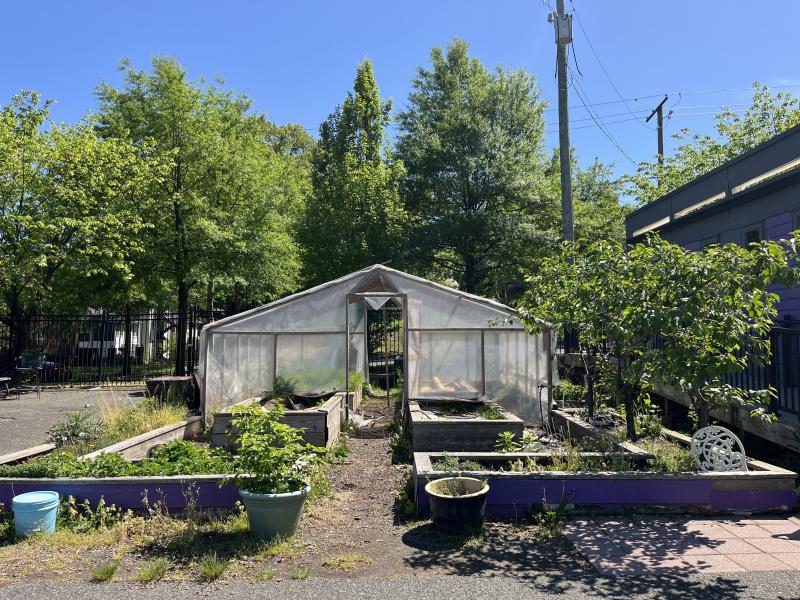“Our school serves students with special abilities and needs ranging from ages 3 to 22 years old. All of the students at our school learn by using the garden...Not only do we use the garden to learn about plants and insects we also use vegetables from the garden to cook weekly meals and learn about nutrition...The garden has a lot of space where people can walk around and look at the plants, vegetables, fruits, herbs, and scarecrows. Some of the students can relax and enjoy the garden and the beautiful scenery. Students also use the garden for our landscaping job site.” - St. Coletta Teacher
Using the school garden as a venue for instruction can be an extremely rewarding experience for the educator and a rich, hands-on, engaging experience for students. Teaching outside requires a specific set of skills, time, resources, and ongoing support to master. Effective garden-based teaching begins with the design and construction of the garden; a well designed and built garden will allow students to engage in hands-on learning. Above all else, the school garden should be an inclusive space, where students of all backgrounds, abilities, genders, and ages are welcome.
Students in the District use school gardens during the school day and out-of-school time through hands-on garden-based learning. These opportunities can lead to increased opportunities for students to participate in independent play, maintenance, and relaxation in a natural setting.
Essential Elements for Garden-Based Teaching
Below are the essential elements for garden-based teaching:
- Curricula: Garden-based curricula can facilitate meaningful experiences in the garden. When these experiences are scaffolded, they often lead to improved student outcomes. The District has adopted the Next Generation Science Standards (NGSS) as the K-12 science standards and the Common Core State Standards in mathematics and English language arts, and Health Education Standards. The school garden is a living laboratory where educators can help students meet these standards through hands-on learning.
- Take Action:
- The following links to external databases may be helpful with finding gardenbased curricula: Sequencing and Sourcing Garden-based Lessons and Garden-based Activities and Lessons.
- Review the Common Core and Next Generation Science Standards in the Garden which includes multiple resources for connecting gardenbased teaching with standards.
- Review the DC Environmental Literacy Plan to understand how environmental education is being integrated into the K12 curriculum.
- Use this Curriculum Map as a guide to align lesson plans to state education standards.
- Read a book to students that reinforces the concepts taught in the school garden using the OSSE Healthy Schools Act Book List (grades K5) or What’s in our Library? (grades preK-5).
- Create a system for collecting, storing, and sharing successful garden lessons.
- Take Action:
- Student Engagement: Garden-based teaching engages students in hands-on inquiry-based learning. To achieve this, consistent routines are important. The more frequently students are taken to the school garden, the easier it will become. Unplanned experiences often occur in the garden, and some are teachable moments (a butterfly sighting can spark a conversation about life cycles), and other times they are distractions (other students on the playground or a sudden change in the weather). An educator who is well prepared with a planned lesson will be able to more easily take advantage of teachable moments and move through distractions.
- Take Action:
- Review the list of Skills Commonly used by Students in the School Garden.
- Watch a garden-based teaching webinar hosted by the School Garden Support Organization Network.
- Take Action:
- Training and Professional Development: Successful school garden programs support teachers to use the school garden to provide meaningful garden-based learning opportunities for students. Teaching in the school garden is quite different from teaching in the classroom, and some teachers may be uncomfortable with taking students outside to learn. This is understandable, as taking students outside to the school garden to teach a lesson can feel daunting. Teachers can gain skills and confidence with training and professional development. It may be worthwhile to partner with an organization that provides professional development for garden-based teaching. The Outdoor Learning ArcGIS Map listed in the DC Outdoor Learning Data Visualization Tools section can assist in finding a partner.
- Attend an upcoming Summer Institute for Garden based Teaching, or Regional Garden-based Learning Summit.
- For more information on training and professional development for teachers, review the Professional Development Models or join a peer-learning community and affinity group.
- Hosted by the School Garden Support Organization.
- For more information on training and professional development for teachers, review the Professional Development Models or join a peer-learning community and affinity group.
- Attend an upcoming Summer Institute for Garden based Teaching, or Regional Garden-based Learning Summit.

“Our garden is the best because it’s an ecosystem. My favorite thing is our pond! Our pond is also an ecosystem ...in there we have fish and algae...Sometimes we see the chickens. Both of them are girls and we feed the chickens and we get the eggs that the chickens have.”- DC Bilingual Public Charter School, K-5


